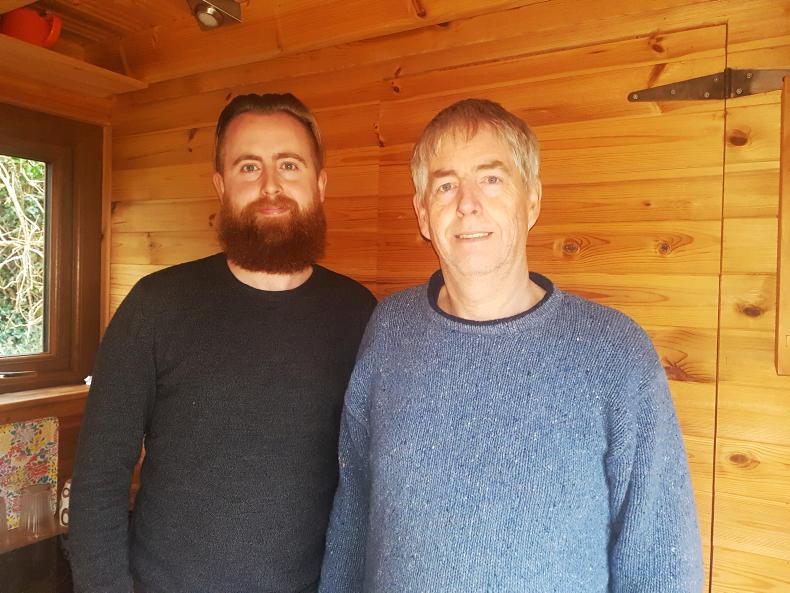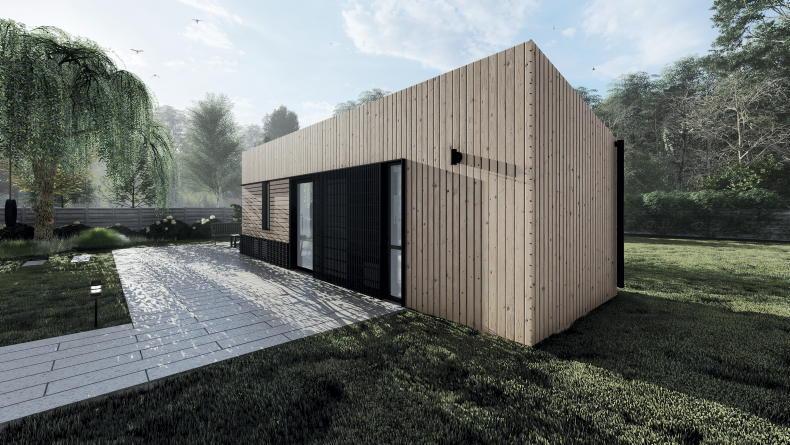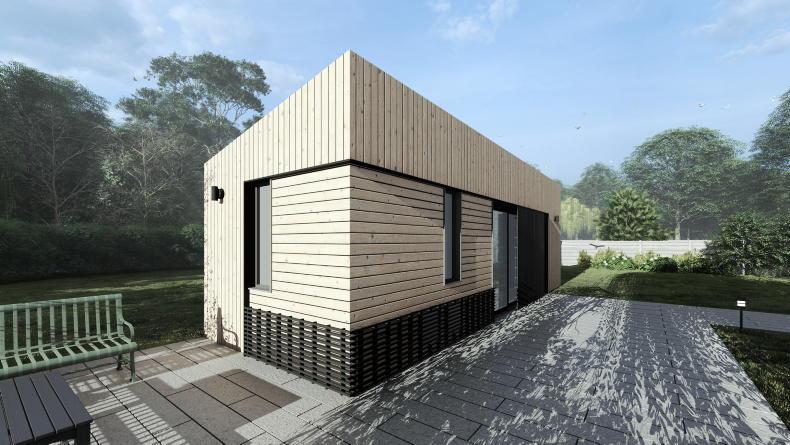There’s an American television series I enjoy watching called Living Off-Grid. It features individuals who dream of living away from the modern world in tiny, eco-friendly houses. It’s an interesting programme, but equally intriguing are the solutions the featured builds can provide for low budgets.

Colla McMahon and his father Steve.
Tiny homes
Tiny homes are what they say on the tin – very small houses which can be built in a relatively short time. Now, if you’re picturing a glorified farm shed; think again. These one- to two-bedroom homes are built to last forever and are reputed to be very comfortable for one or two residents; with an average building energy rating (BER) of A2.
Today, many young adults can’t secure a mortgage for a new home. As long as you have the land, tiny homes offer the opportunity to live independently, as well as rent or mortgage-free. Once in a tiny home, residents can start saving for the future – if they build or buy a new home; the tiny home can be rented, used as a home office or even sold (they are fully transportable).
Colla McMahon co-owns and operates Tiny Homes Ireland (tinyhomes.ie) with his father, Stephen, in Coolbawn, Co Tipperary. He says there are a variety of reasons their clients build tiny homes.
“[Our clients] tend to fall into three broad categories,” he says. “First time homeowners, or younger people, looking to get on the property ladder are the first. Then there are last-time homeowners – generally people in their 60s, 70s and 80s who may have been living in a large home, have lots of equity tied into it, but are looking to downsize. Finally, we have people who are looking to make a return on an investment. Many build tiny homes on their property to be used as rentals or Airbnbs.”

Quick builds – low cost
Colla, whose background is in carpentry, social policy and housing, joined forces with his father – who is also a carpenter and builder with over 30 years’ experience – to start designing tiny homes for the Irish market in 2018. Through his studies, Colla learned the value these homes could have and how they could help solve common housing issues. Prices for tiny homes vary according to individual requirements. Colla and Stephen’s most basic structural build starts at €18,000 (plus VAT), while a live-in-ready home starts at €29,000 (plus VAT).
“Our prices generally range from €18,000-50,000,” Colla says. “With delays due to COVID-19, we need between six to 14 weeks turnaround [for their complete build]. In normal times, it takes about six to 10 weeks.”
Energy efficient
Because tiny homes are often built with a box-style design, they are easy to insulate and require minimal heating.
“We’re able to build them in a way that’s airtight,” Colla explains. “We use a combination of different insulations, which allows for an extremely energy efficient structure. Having an electric heater in each room is usually sufficient [for heating the house].”
Before you build
There are important considerations to make before ordering a tiny home for your property; including planning permission and financial help to build.
“Planning permission is ambiguous and differs depending on your location,” Colla says. “There’s no one answer to any given situation. When we speak to our clients, I ask them a lot of questions and then offer advice according to their specific situation.”
Banks won’t give mortgages for tiny homes, but the cost is often so minimal (compared to a standard build), many choose to self-fund or can access a smaller loan through their baking institution.
Insurance for tiny homes can be added on from the main existing house, if there is one on the property – otherwise, tiny homes require the same home insurance as any other house. CL
Off-grid living
For those looking to power their tiny homes independently, there are a few options to consider including solar PV panels for electricity and hot water, rain water harvesting and composting – or “dry” toilets (if the site does not have a septic tank).
Prices for composting toilets start at around €500 and work by separating solid and liquid waste.
Because the toilets are designed to quickly break waste down into compost; odour is less of an issue than in other non-plumbing toilets.
Rainwater harvesting systems can be as simple as collecting rainwater in a barrel or as elaborate as an underground filtration system, which disinfects the water with ultra-violet rays and can be used for household water needs, like laundry and toilets or showers (take note: it isn’t drinkable).
In correspondence with Irish Country Living, Thomas McNally of Rainwater Harvesting Systems (rainwaterharvestingsystemsireland.com) in Quigley’s Point, Co Donegal says these systems serve homes in times of drought, significantly cut down of domestic water waste and, for those off-grid, water pumps can also solar powered.
“Anyone incurring water bills is our primary customer,” he says. “We supply lots of farmers and commercial buildings but, in the past 18 months, there has been an increase in residential dwellings going with rainwater harvesting. The reason for this is it’s a natural water source and rainwater is softer [than most other water sources].”
Referring to their underground ‘shallow dig’ systems, which they manufacture, he says “our tanks have 1500, 3000, 5000 litre capacities and you can have either the direct pumped or gravity fed system with any tank.” Prices range between €1,500 and €3,500, with exact costing given as per each job requirement.
There’s an American television series I enjoy watching called Living Off-Grid. It features individuals who dream of living away from the modern world in tiny, eco-friendly houses. It’s an interesting programme, but equally intriguing are the solutions the featured builds can provide for low budgets.

Colla McMahon and his father Steve.
Tiny homes
Tiny homes are what they say on the tin – very small houses which can be built in a relatively short time. Now, if you’re picturing a glorified farm shed; think again. These one- to two-bedroom homes are built to last forever and are reputed to be very comfortable for one or two residents; with an average building energy rating (BER) of A2.
Today, many young adults can’t secure a mortgage for a new home. As long as you have the land, tiny homes offer the opportunity to live independently, as well as rent or mortgage-free. Once in a tiny home, residents can start saving for the future – if they build or buy a new home; the tiny home can be rented, used as a home office or even sold (they are fully transportable).
Colla McMahon co-owns and operates Tiny Homes Ireland (tinyhomes.ie) with his father, Stephen, in Coolbawn, Co Tipperary. He says there are a variety of reasons their clients build tiny homes.
“[Our clients] tend to fall into three broad categories,” he says. “First time homeowners, or younger people, looking to get on the property ladder are the first. Then there are last-time homeowners – generally people in their 60s, 70s and 80s who may have been living in a large home, have lots of equity tied into it, but are looking to downsize. Finally, we have people who are looking to make a return on an investment. Many build tiny homes on their property to be used as rentals or Airbnbs.”

Quick builds – low cost
Colla, whose background is in carpentry, social policy and housing, joined forces with his father – who is also a carpenter and builder with over 30 years’ experience – to start designing tiny homes for the Irish market in 2018. Through his studies, Colla learned the value these homes could have and how they could help solve common housing issues. Prices for tiny homes vary according to individual requirements. Colla and Stephen’s most basic structural build starts at €18,000 (plus VAT), while a live-in-ready home starts at €29,000 (plus VAT).
“Our prices generally range from €18,000-50,000,” Colla says. “With delays due to COVID-19, we need between six to 14 weeks turnaround [for their complete build]. In normal times, it takes about six to 10 weeks.”
Energy efficient
Because tiny homes are often built with a box-style design, they are easy to insulate and require minimal heating.
“We’re able to build them in a way that’s airtight,” Colla explains. “We use a combination of different insulations, which allows for an extremely energy efficient structure. Having an electric heater in each room is usually sufficient [for heating the house].”
Before you build
There are important considerations to make before ordering a tiny home for your property; including planning permission and financial help to build.
“Planning permission is ambiguous and differs depending on your location,” Colla says. “There’s no one answer to any given situation. When we speak to our clients, I ask them a lot of questions and then offer advice according to their specific situation.”
Banks won’t give mortgages for tiny homes, but the cost is often so minimal (compared to a standard build), many choose to self-fund or can access a smaller loan through their baking institution.
Insurance for tiny homes can be added on from the main existing house, if there is one on the property – otherwise, tiny homes require the same home insurance as any other house. CL
Off-grid living
For those looking to power their tiny homes independently, there are a few options to consider including solar PV panels for electricity and hot water, rain water harvesting and composting – or “dry” toilets (if the site does not have a septic tank).
Prices for composting toilets start at around €500 and work by separating solid and liquid waste.
Because the toilets are designed to quickly break waste down into compost; odour is less of an issue than in other non-plumbing toilets.
Rainwater harvesting systems can be as simple as collecting rainwater in a barrel or as elaborate as an underground filtration system, which disinfects the water with ultra-violet rays and can be used for household water needs, like laundry and toilets or showers (take note: it isn’t drinkable).
In correspondence with Irish Country Living, Thomas McNally of Rainwater Harvesting Systems (rainwaterharvestingsystemsireland.com) in Quigley’s Point, Co Donegal says these systems serve homes in times of drought, significantly cut down of domestic water waste and, for those off-grid, water pumps can also solar powered.
“Anyone incurring water bills is our primary customer,” he says. “We supply lots of farmers and commercial buildings but, in the past 18 months, there has been an increase in residential dwellings going with rainwater harvesting. The reason for this is it’s a natural water source and rainwater is softer [than most other water sources].”
Referring to their underground ‘shallow dig’ systems, which they manufacture, he says “our tanks have 1500, 3000, 5000 litre capacities and you can have either the direct pumped or gravity fed system with any tank.” Prices range between €1,500 and €3,500, with exact costing given as per each job requirement.








 This is a subscriber-only article
This is a subscriber-only article





SHARING OPTIONS: